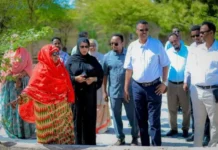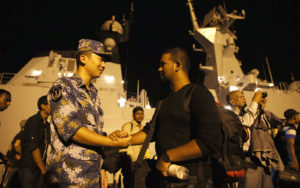Chinese troops evacuating Sri Lankan civilians from Yemen in 2015. Photo: Xinhua
Why Djibouti?
China formally opened its first overseas military base on August 1, 2017 — the same day that the People’s Liberation Army celebrated its 90th birthday. Beijing says Djibouti is ideally placed for China to resupply peacekeeping and humanitarian missions and combat piracy off the coasts of Yemen and Somalia.
A former French colony, the multi-ethnic Republic of Djibouti is about the size of Wales. It occupies 23,200km sq of mostly volcanic desert, is devoid of natural resources, and has a population below a million. However, the country’s location is of key strategic value. Situated on the northwestern edge of the Indian Ocean, at the southern entrance to the Red Sea, Djibouti controls access to the Suez Canal and the Indian Ocean, home to some of the world’s busiest shipping lanes. Djibouti offers China the ability to operate military missions far from home.
Not everyone views China’s base as entirely benevolent. New Delhi has voiced concerns that the naval and logistics facility is part of a broader plan to establish another “string of pearls”, with Bangladesh, Myanmar and Sri Lanka, encircling India. There have also been persistent rumours that China intends to build more bases in countries such as Pakistan. Beijing strenuously denies these claims. US lawmakers warned there would be ‘significant’ consequences should there be a Chinese takeover of Djibouti’s port operations.
Djibouti’s Finance Minister Ilyas Dawaleh has said, “Djibouti’s development needs all its friends and strategic partners. At the same time, no one can dictate to us who we should deal with.”
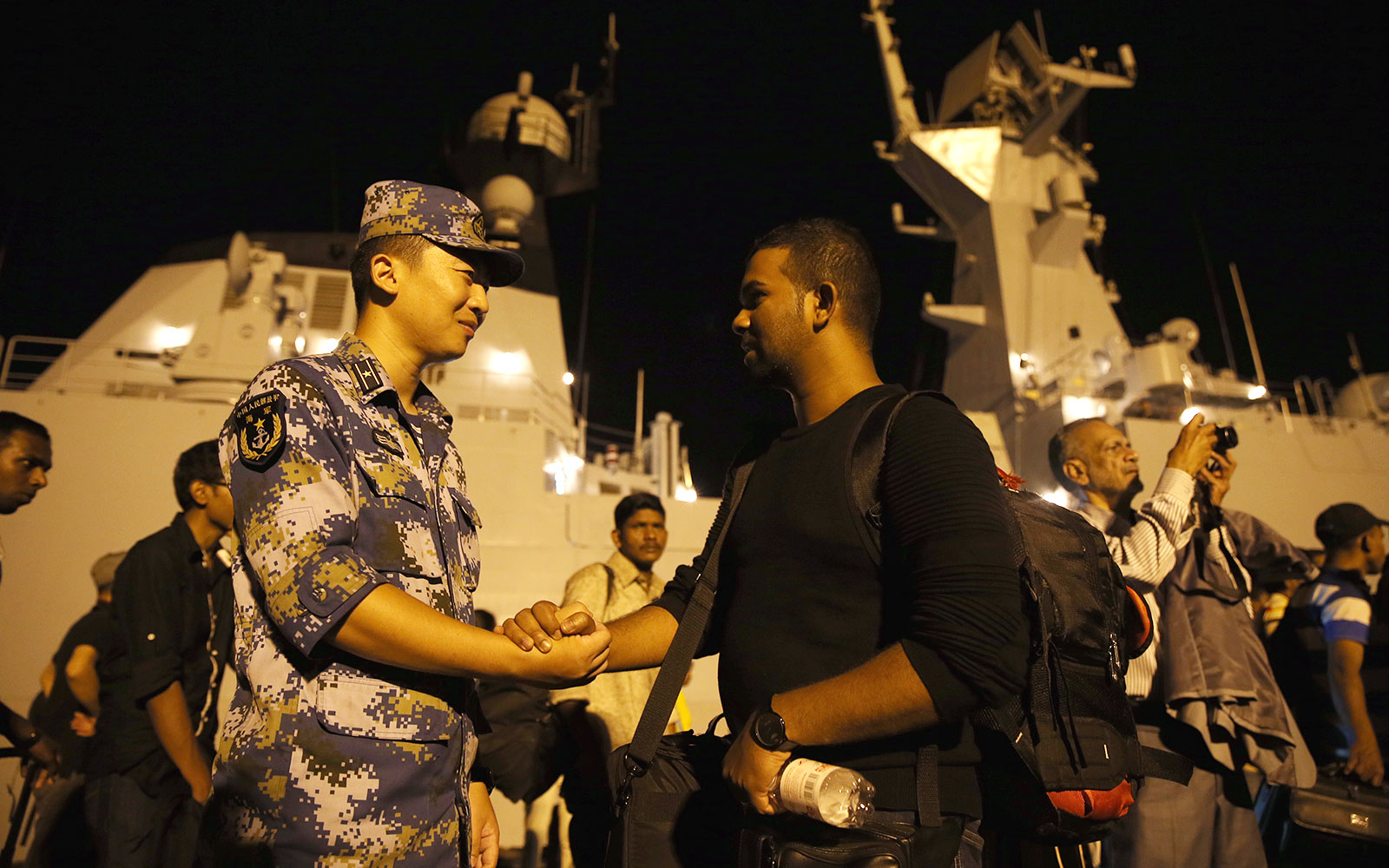

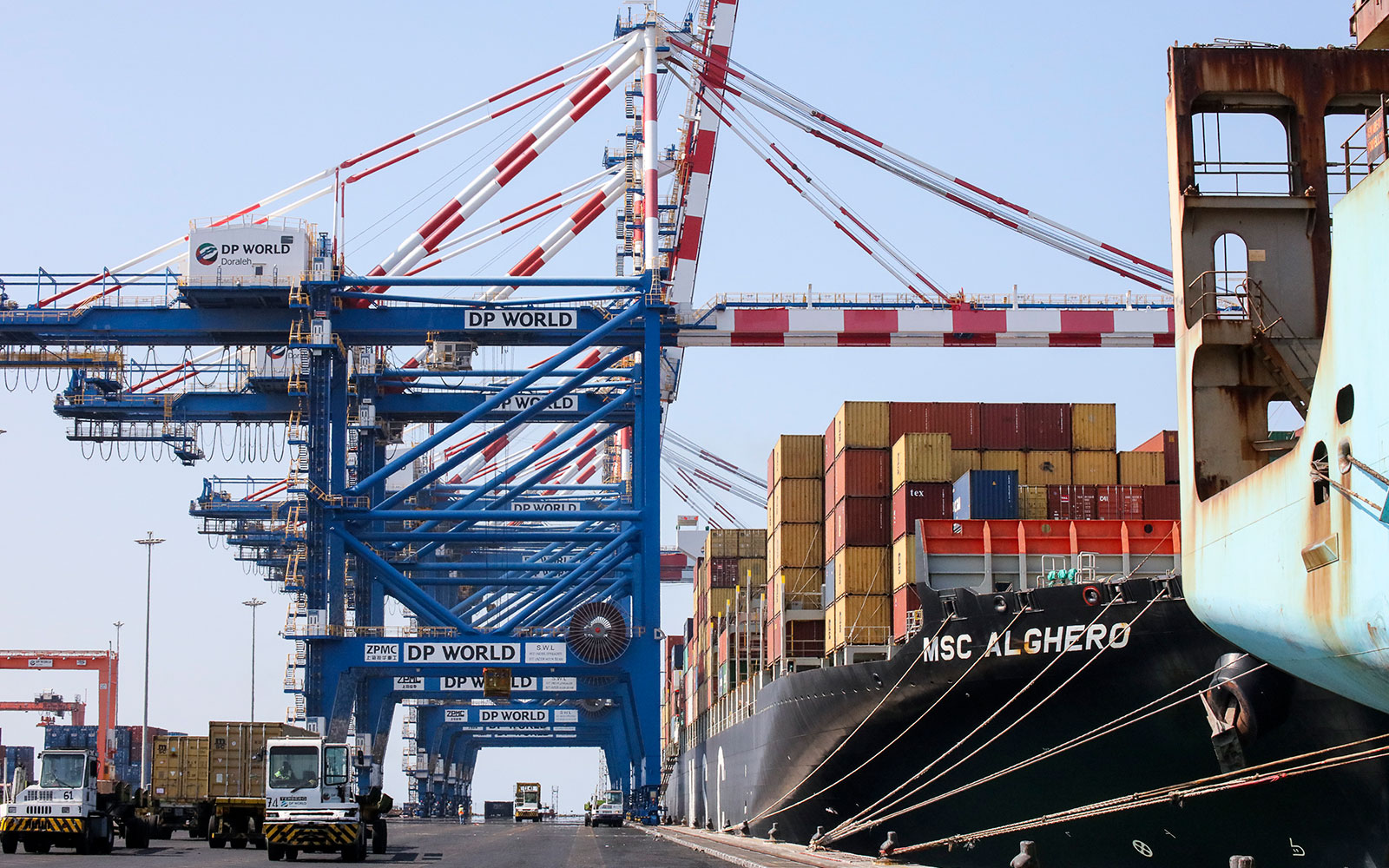


-
Countries affected by conflict 2018
-
Evacuations of non-combatant Chinese nationals 2006-2015
-
Locations rumoured to be potential future overseas bases for China
Overseas US military bases 2017
-
Areas at risk from piracy 2017
-
China’s “Belt and Road Initiative”

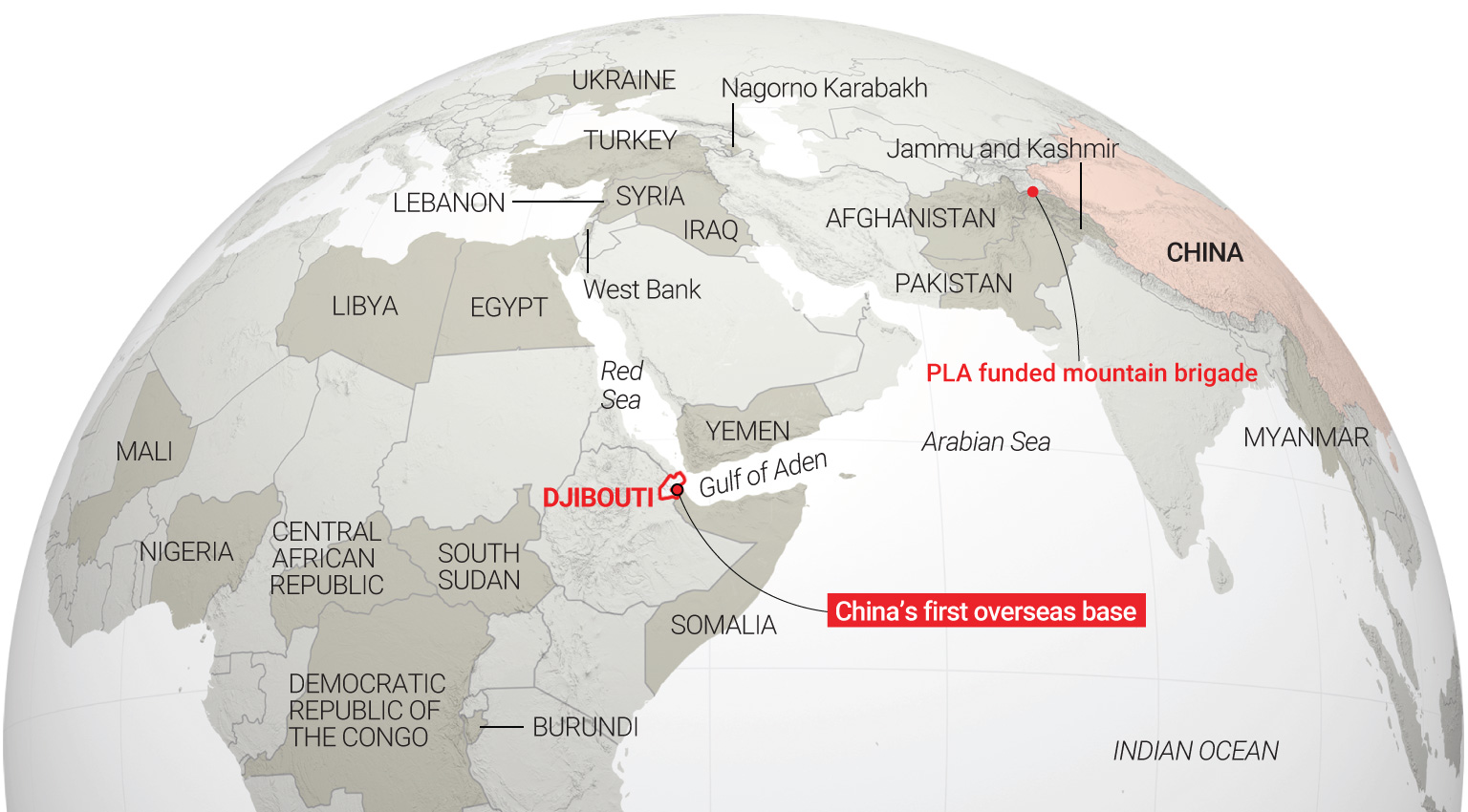
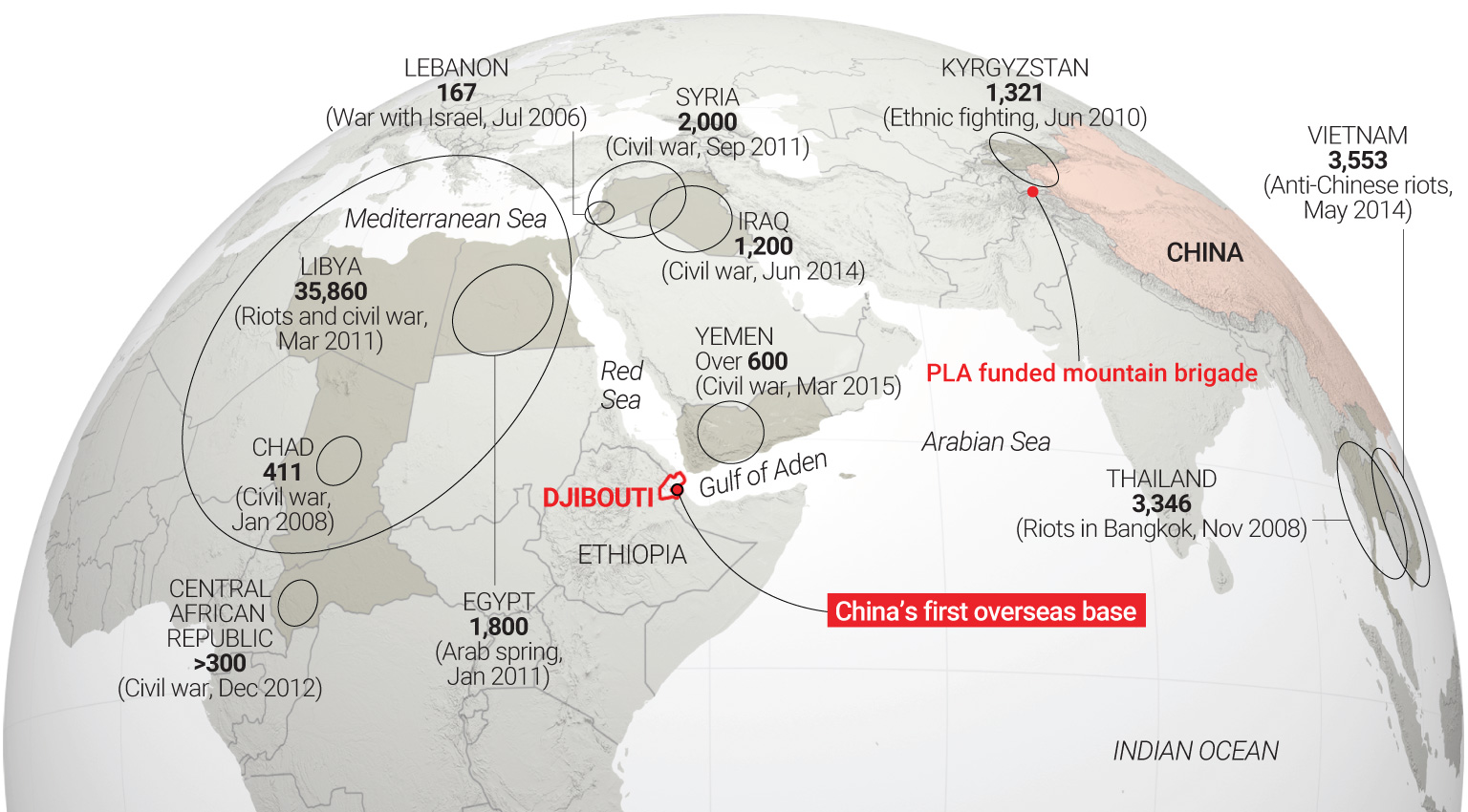
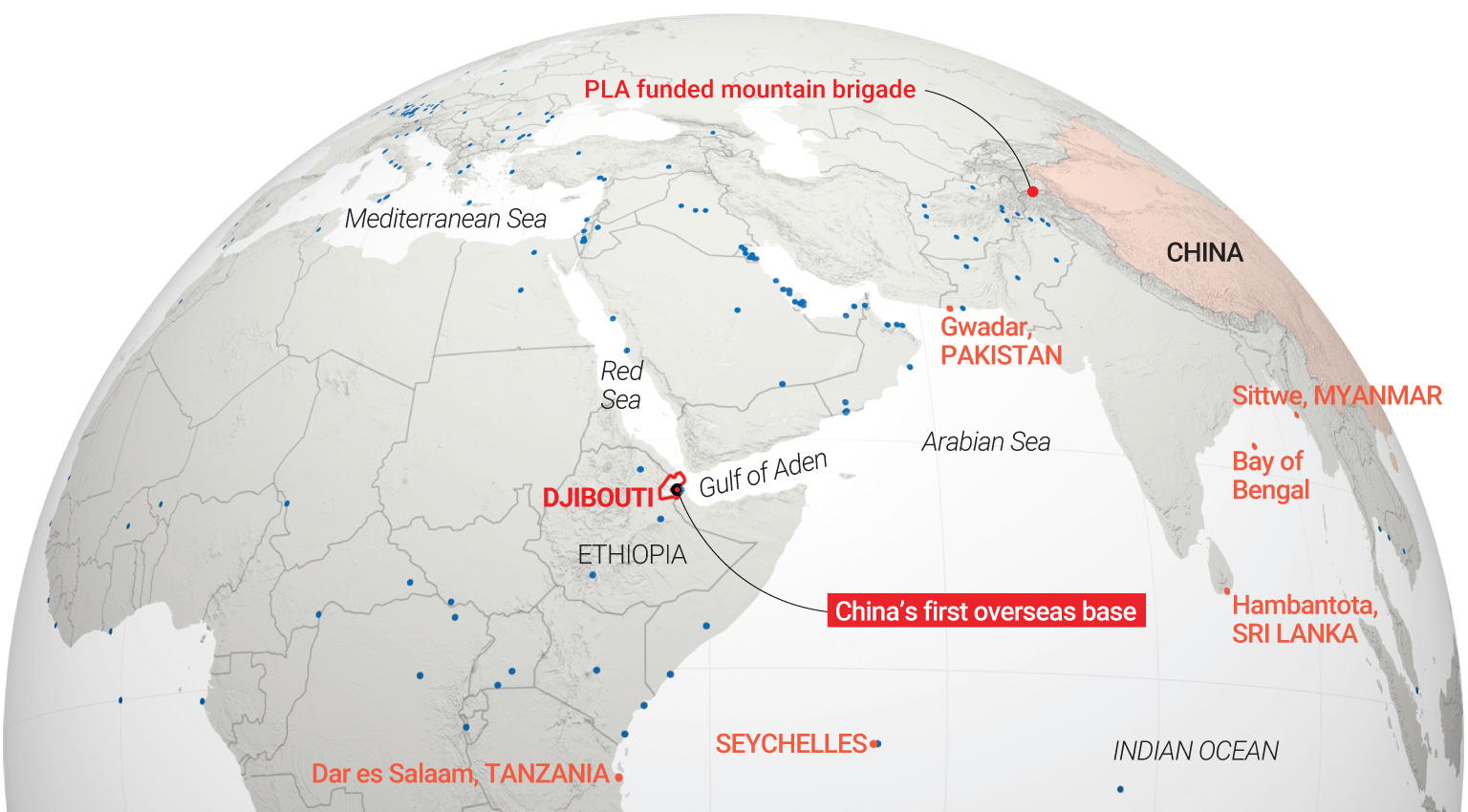

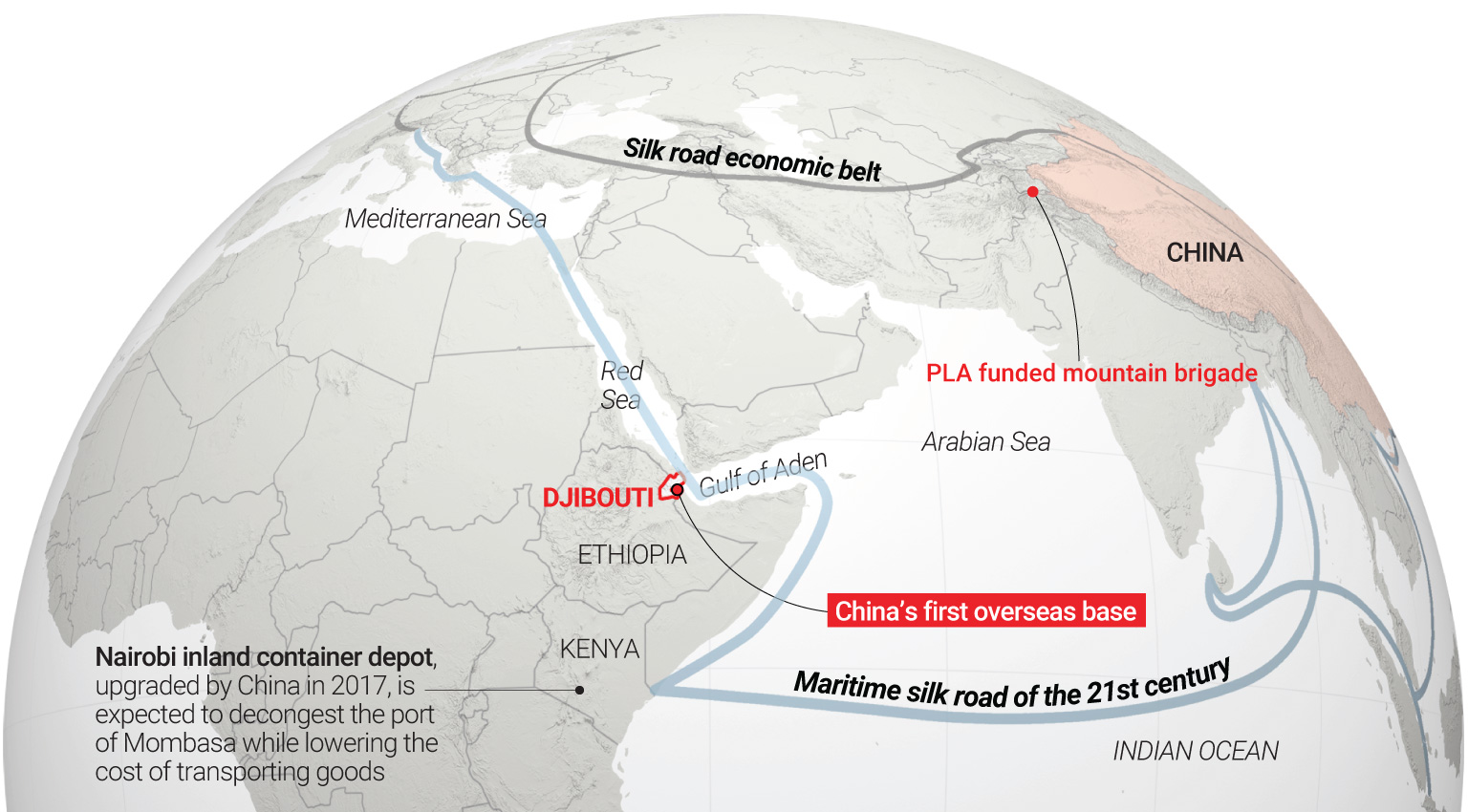
Show of force
Djibouti is home to more foreign bases than any other country. Since the turn of the century the US, and various European and Asian countries, have set up military camps there. Analysts say the country’s geostrategic location and its recent stability in a volatile region has turned it into a military playground for world powers.
s After the events of September 11, 2001, the US established Camp Lemonnier to combat terrorist threats from Yemen and the Horn of Africa. Japan’s first foreign military base since the second world war is also situated in Djibouti and is set to expand as a counterweight to China’s increasing influence in the region. Italy has its own base, while German and Spanish troops are hosted by the French.
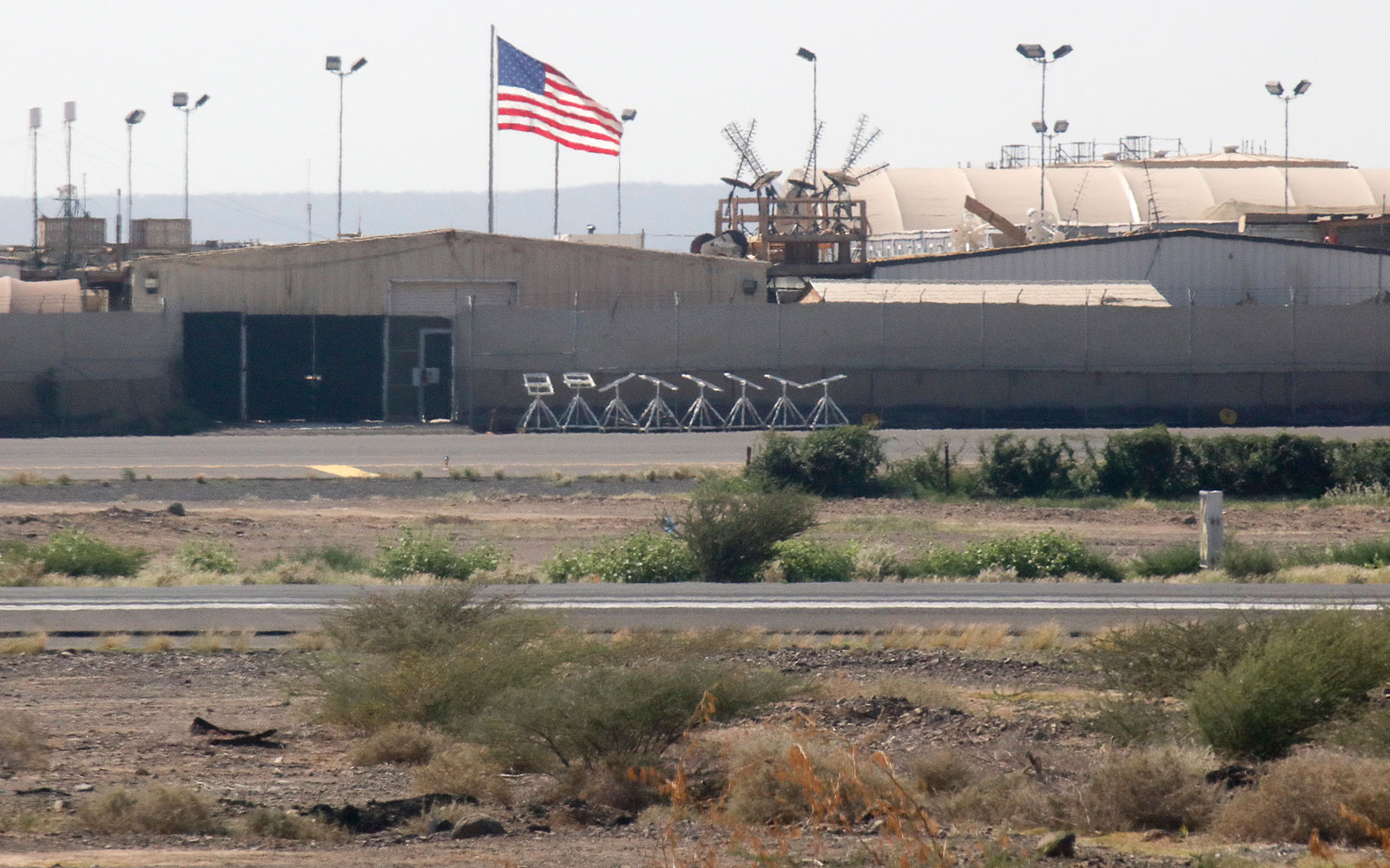




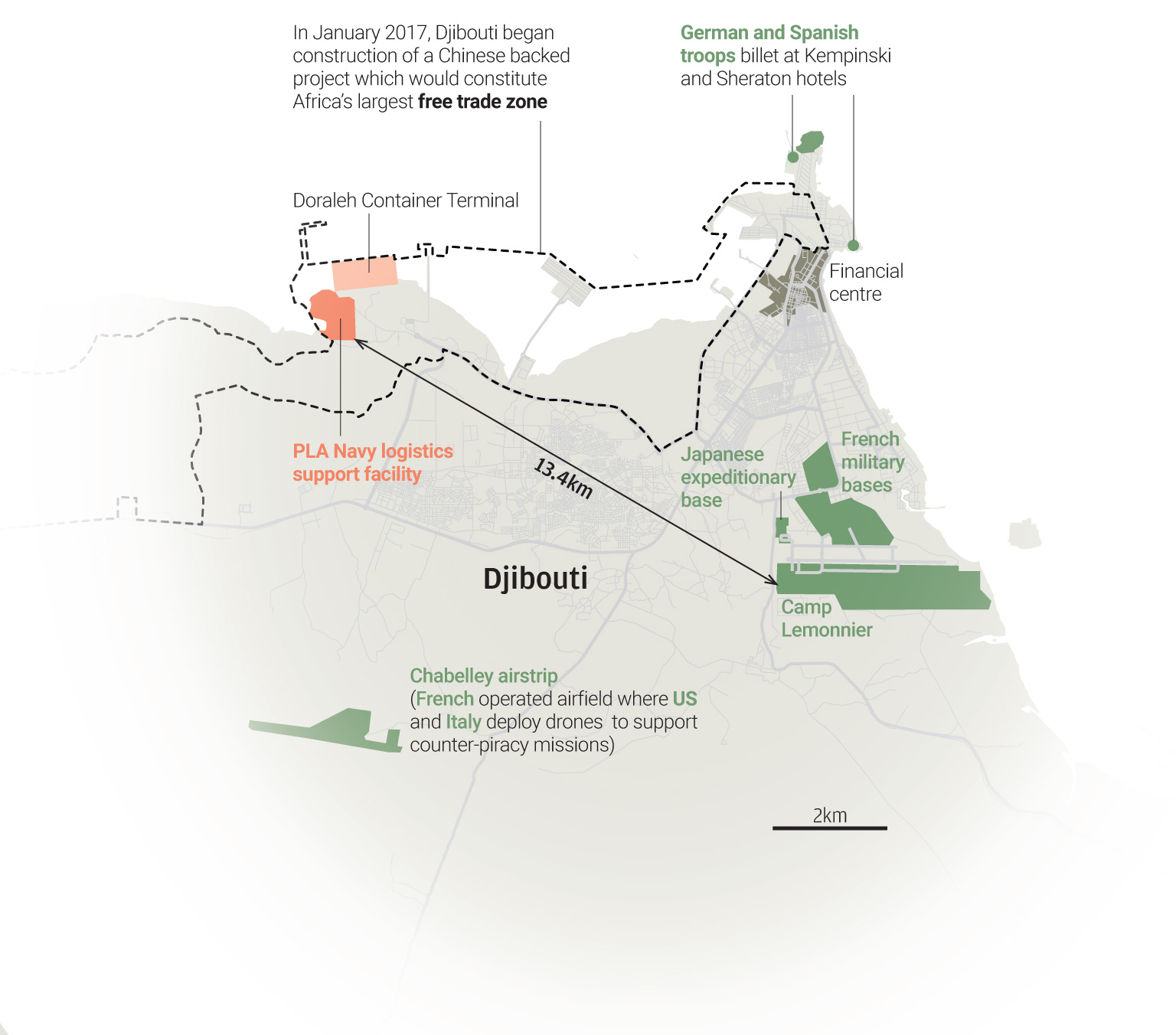
Western media speculate China’s military facility could accommodate up to 10,000 personnel

The naval base and Doraleh Container Terminal built by China
Countering piracy Support escort missions in the Gulf of Aden and pirate-infested Somali waters.
Intelligence China can potentially gather information on other countries’ military activities in Africa.
Protect Chinese nationals China can evacuate its nationals during conflicts. There is an increasing number of non-combatant expatriates working in the volatile region.
International peacekeeping China currently has over 2,507 UN peacekeeping troops in Africa.
Counterterrorism: Chinese nationals living and working in the region face significant threats from terrorism
Money Matters
Djibouti’s economic activity is centred on its port facilities, the Addis Ababa-Djibouti railway, and foreign military bases, with industry accounting for less than 20 per cent of GDP. Increased investment, particularly in construction and port operations, has led to relatively high economic growth in recent years.





Source of income
A poor country with high unemployment rates, the rents from foreign military bases are a boon to Djibouti’s economic growth
 Source: 2017 International Monetary Fund
Source: 2017 International Monetary Fund
Economic growth
Djibouti has enjoyed rapid and sustained growth over the past 15 years
 Source: Knoema
Source: Knoema




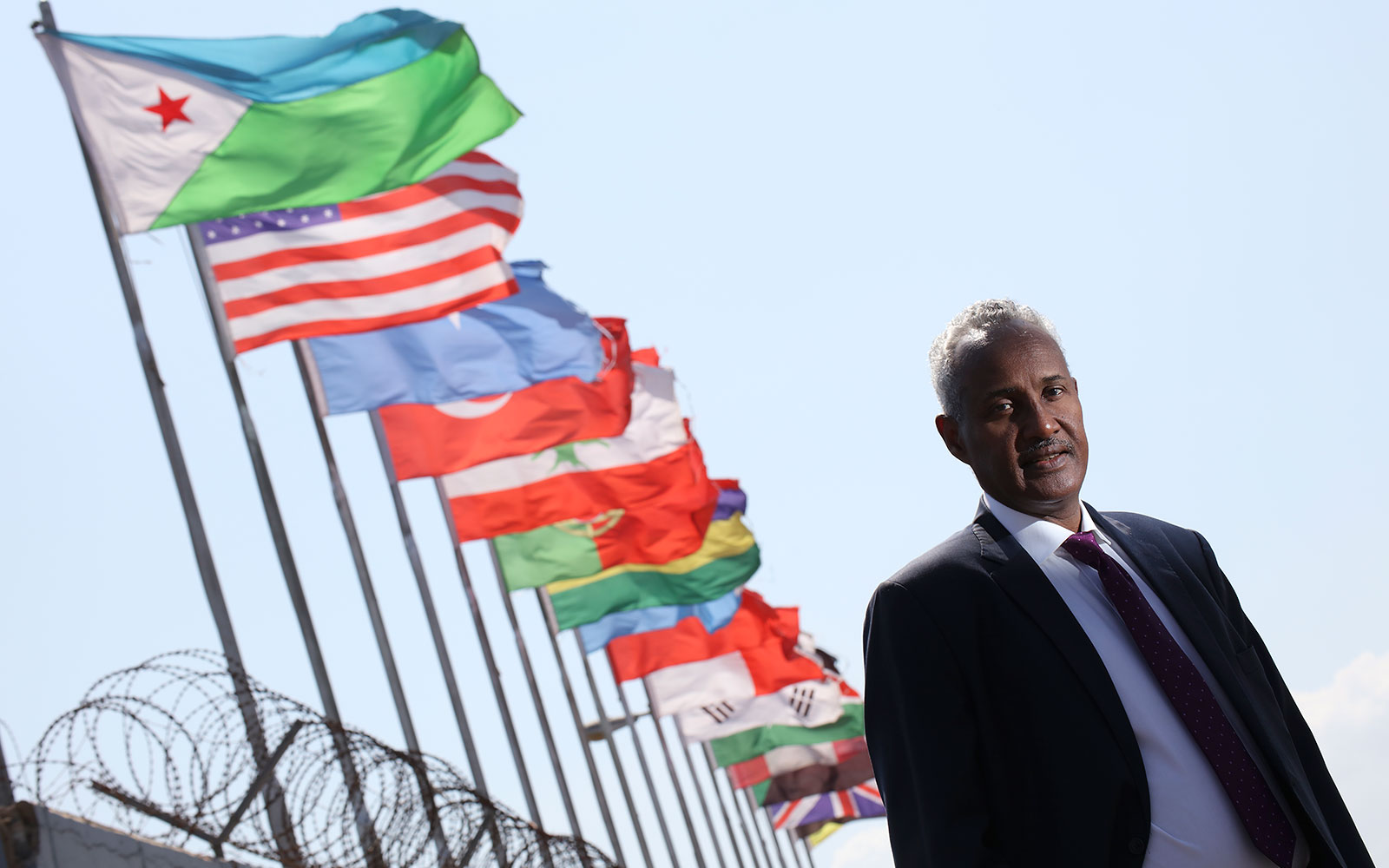
Economic interests
Blessed with a deep natural harbour, Djibouti’s real asset is its geostrategic location. With access to the Gulf of Aden, the Gulf of Arabia, and the Bab-el-Mandeb Strait, Djibouti effectively controls economic trade routes accounting for 20 per cent of all global exports, and 10 per cent of total oil export transits annually.
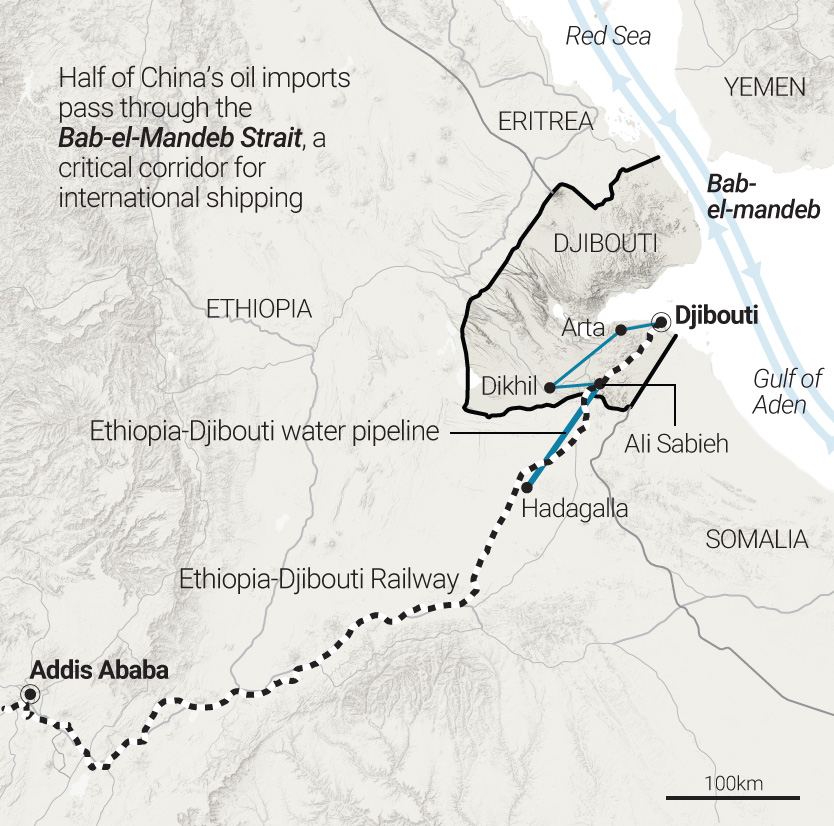 Business opportunities for China
Business opportunities for China
• Explore new overseas markets as demand for domestic infrastructure projects slows.
• Showcase Chinese technology to attract new business opportunities.
• Support President Xi Jinping’s “Belt and Road Initiative.”
• More than 95 per cent of Ethiopia’s trade passes through Djibouti which accounts for 70 per cent of the activity at the Doraleh Container Terminal.
• The port is yet to reach its full potential of 1.6 million tonnes annual capacity.
China is Djibouti’s largest single source of capital. Chinese firms fund nearly 40 per cent of Djibouti’s major investment projects
 Addis Ababa-Djibouti railway
Addis Ababa-Djibouti railwayCost: US$490m
Financed by: China
- ❯
- ❮
Difficult lives
Despite remarkable growth, poverty and unemployment remain widespread in Djibouti
 Sources: CIA World Factbook, Worldometers
Sources: CIA World Factbook, Worldometers
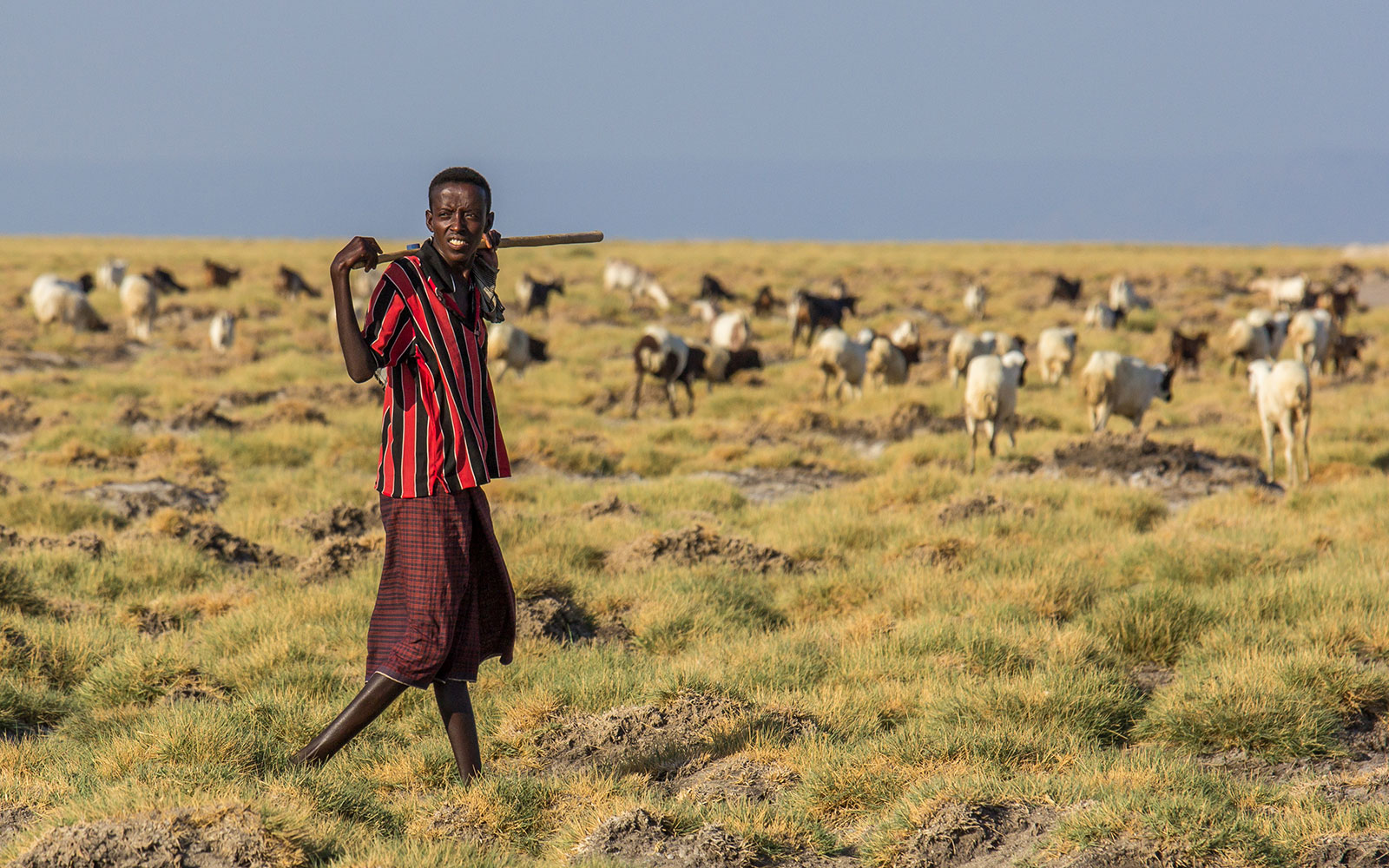




The Djibouti government aspires to transform the country into a sea-air transshipment hub for the whole of Africa. Most of the country’s infrastructure-related projects are financed by China but earlier this year French shipping company CMA CGM entered discussions to develop a new container terminal.
Djibouti President Ismail Omar Guelleh met with President Xi Jinping in a three-day visit to China in November, 2017. Both leaders reiterated their commitment to deepening ties and cooperation, and emphasised Djibouti’s location as a strategic choke point near the Red Sea, en route to the important Suez Canal maritime artery.
Collaboration or conflict?
As the world’s most powerful nations set up camp in Djibouti, it remains to be seen if their proximity will lead to greater collaboration or become a flashpoint for conflict
China, the US, and various European countries initially saw Djibouti as a window to band together with the United Nations to protect the world’s busiest trade routes.
The European Union’s anti-piracy mission in the Arabian Sea reports that at the peak of Somali piracy in January 2011, pirates held 736 hostages and 32 vessels. Following the concerted efforts of the international community, those figures were cut to zero by 2016 with the People’s Liberation Army Navy (PLAN) playing a significant role.
Despite the recent successes in the fight against piracy the risk of being attacked at sea remains a constant threat.
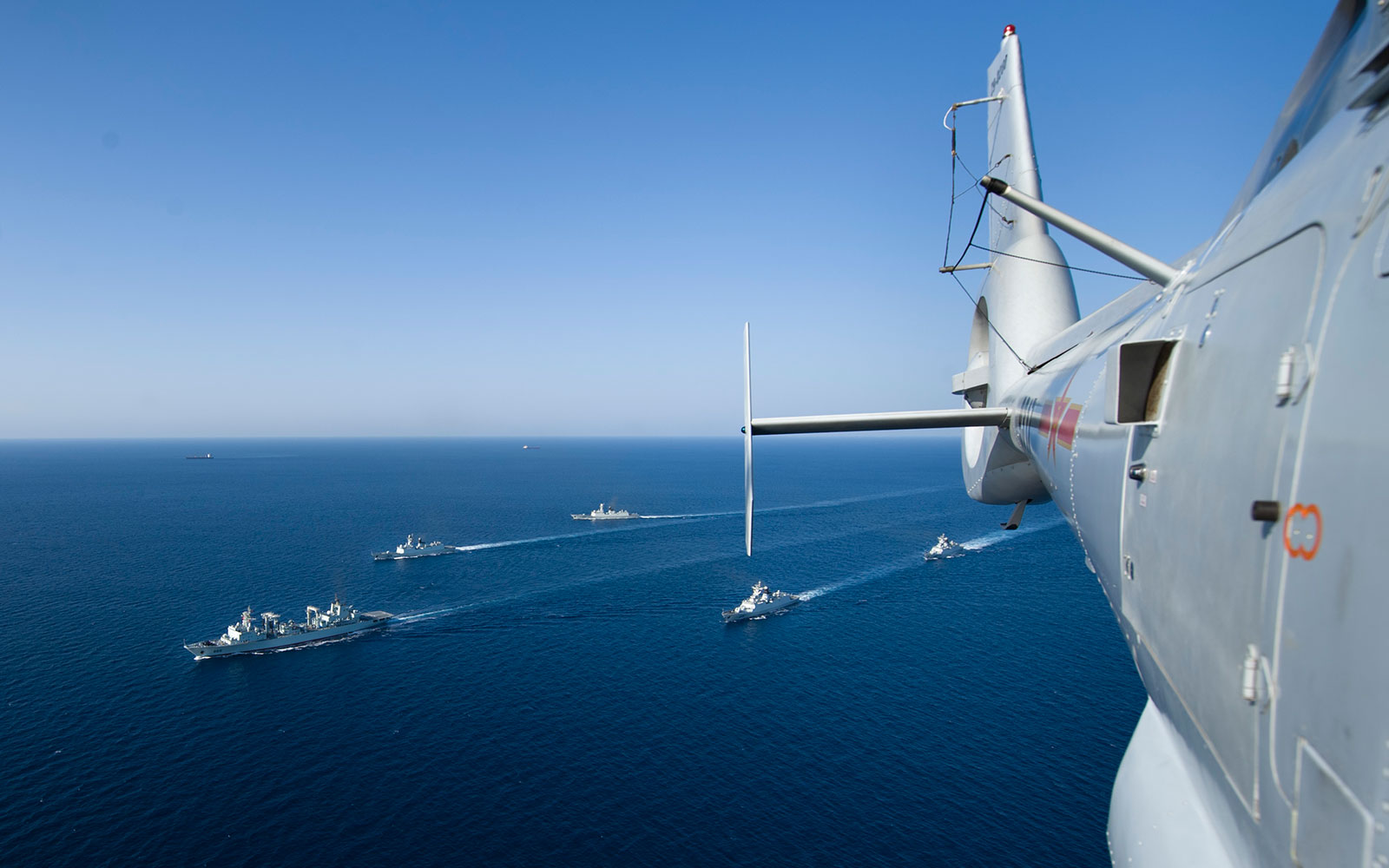




2018
2017
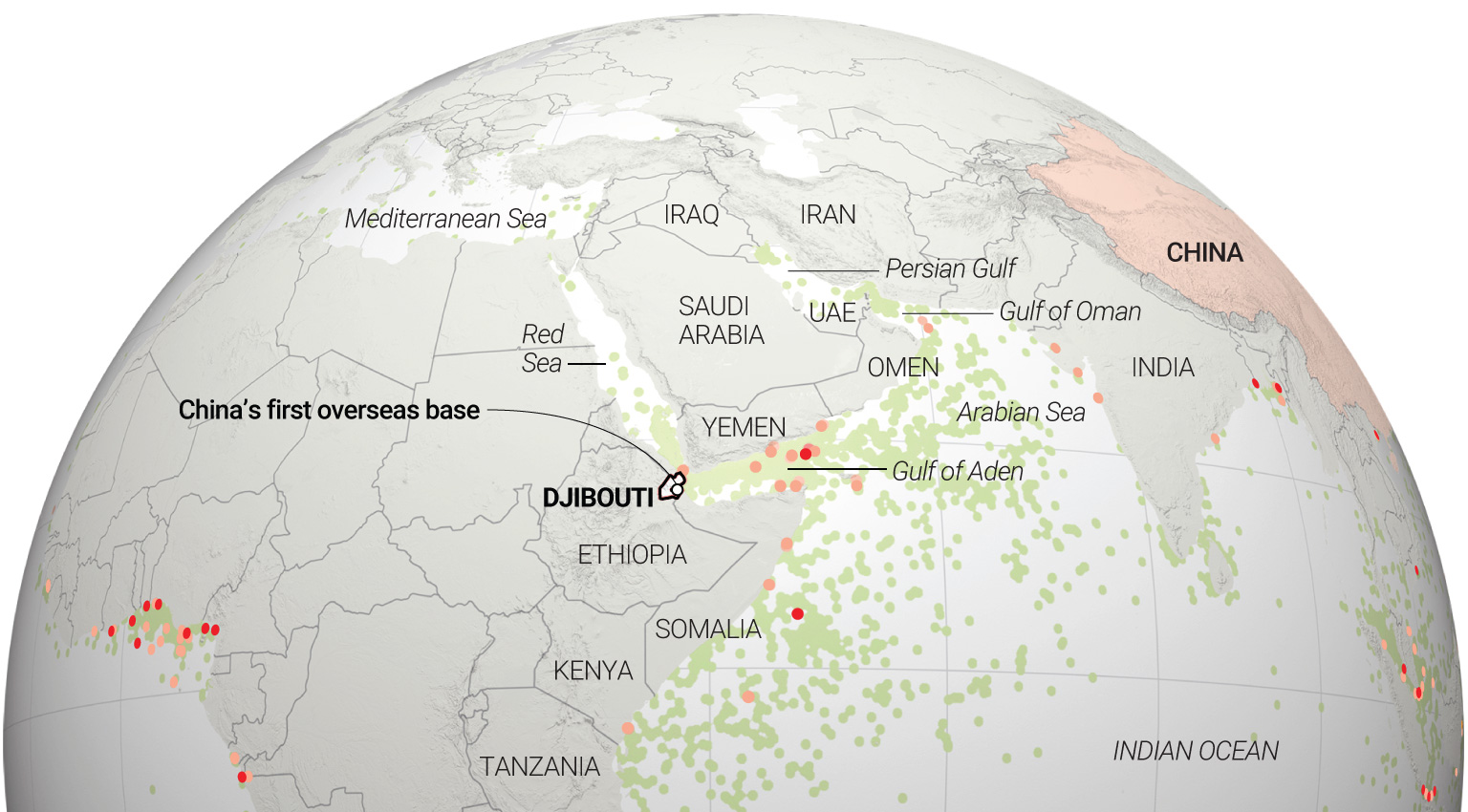

Global since 1978
Middle East
Sources: ICC Commercial Crime Services, UNOSAT Global Report, National Imagery and Mapping Agency
Simmering tensions
But tensions have begun to rise since initial collaborations and successes.
This spring, the Pentagon said two US pilots were injured when military-grade laser weapons were fired into their eyes within a kilometre of China’s new military logistics facility in Djibouti.
On May 4, 2018, US officials lodged a formal diplomatic complaint demanding Beijing investigate. The US Department of Defense alleges similar incidents occurred in previous weeks claiming “this activity poses a true threat to our airmen”. China’s Ministry of National Defence dismisses the accusations as being “in complete contradiction of the facts.”
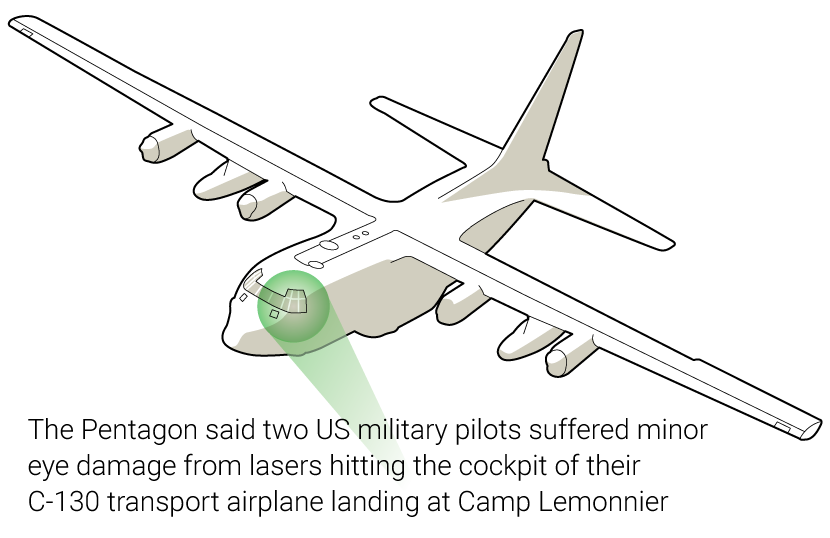 PLA military experts told the South China Morning Post it is possible the injuries were caused by a type of laser commonly deployed around airports to keep birds away from landing strips.
PLA military experts told the South China Morning Post it is possible the injuries were caused by a type of laser commonly deployed around airports to keep birds away from landing strips.
What is certain is that China has been developing laser weapons as part of President Xi Jinping’s push to modernise military technology and equipment. There are two main categories of tactical laser weapons to have been revealed by China in recent years.
Tactical laser weapon systems
The systems target slow and low-flying unstaffed aerial vehicles, missiles, and aircraft. Known systems include the Low-air Guard I and II, The Silent Hunter, Guorong-I anti-drone system, and High Shield Comprehensive Optoelectronic Defence System.
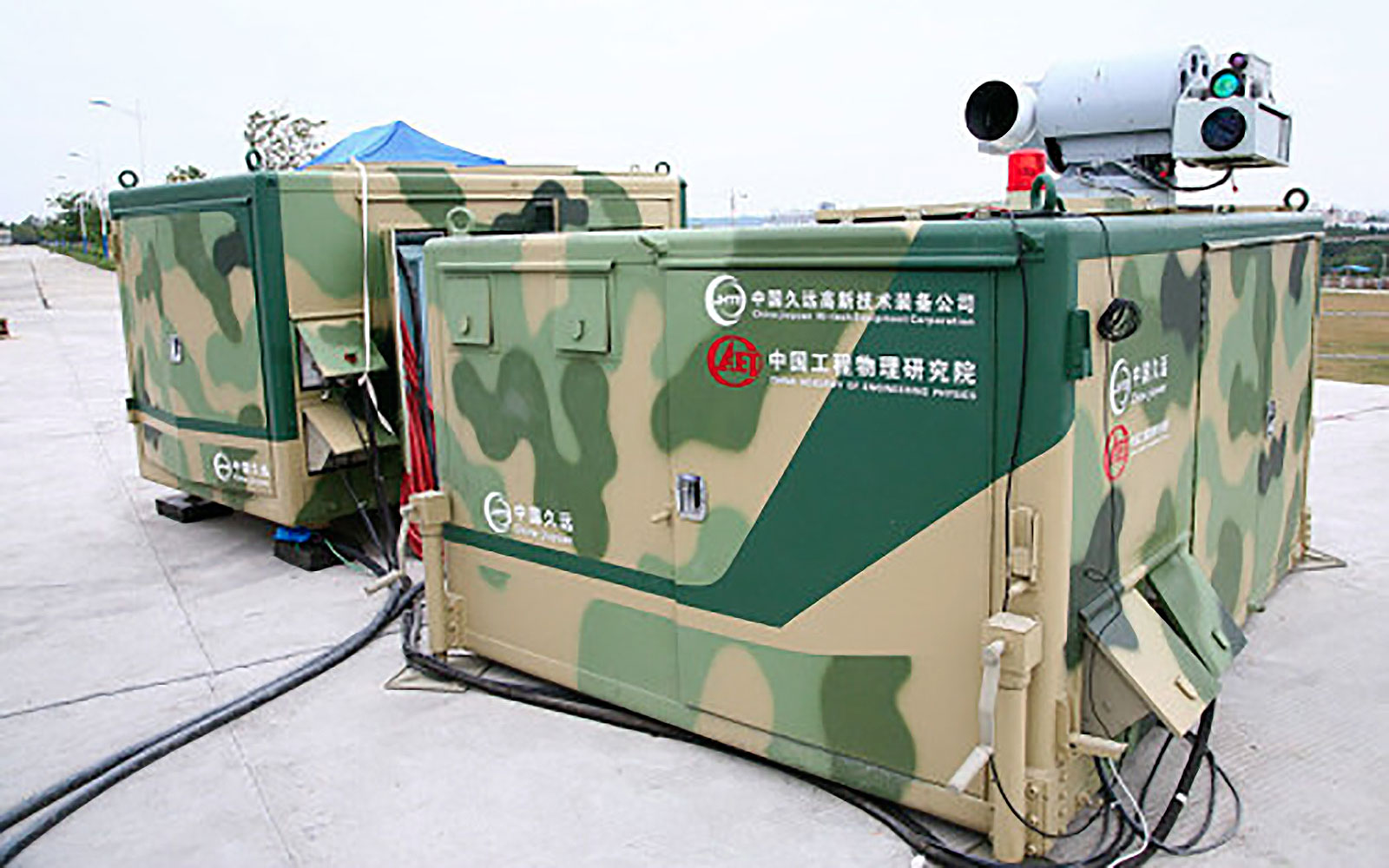

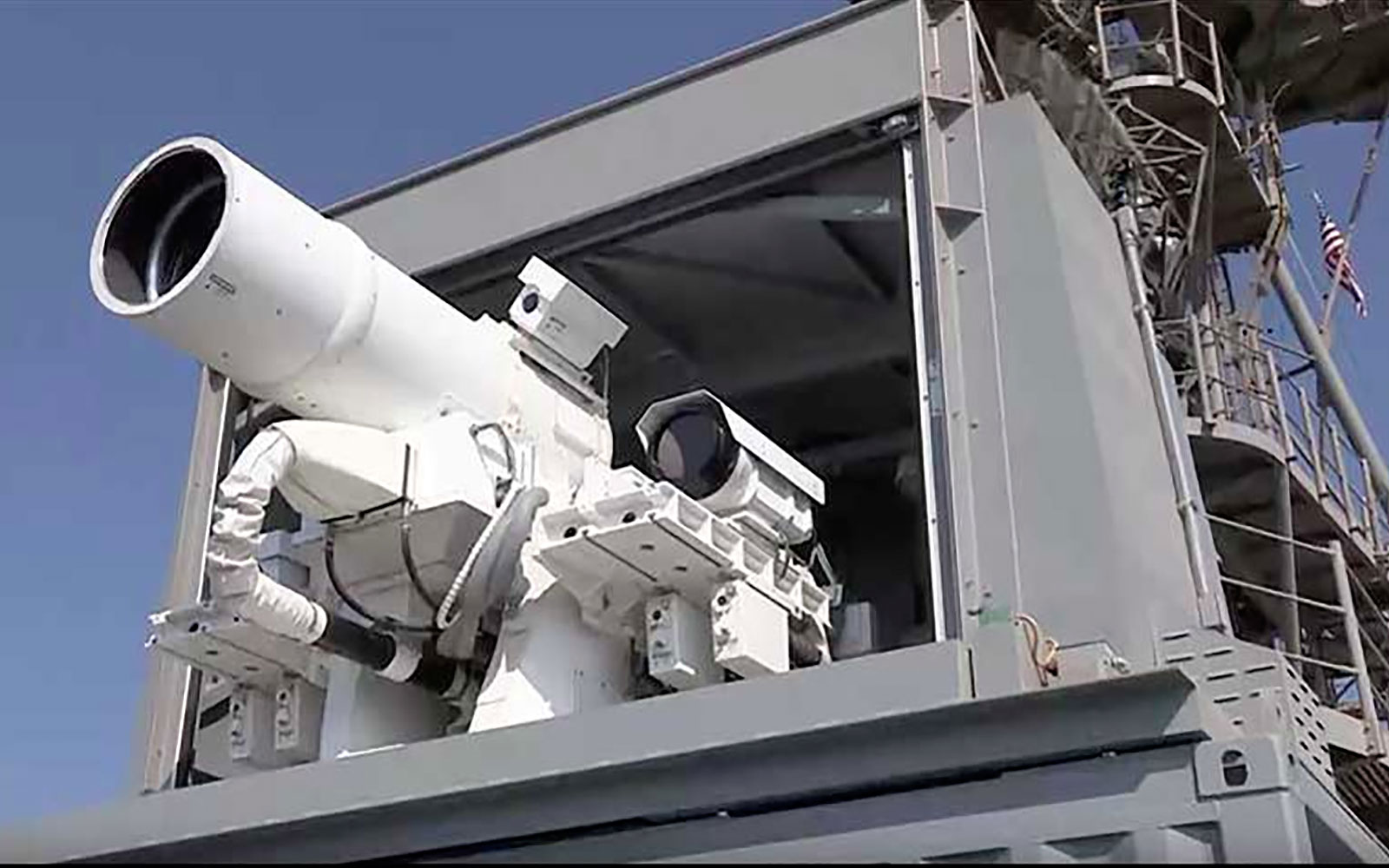

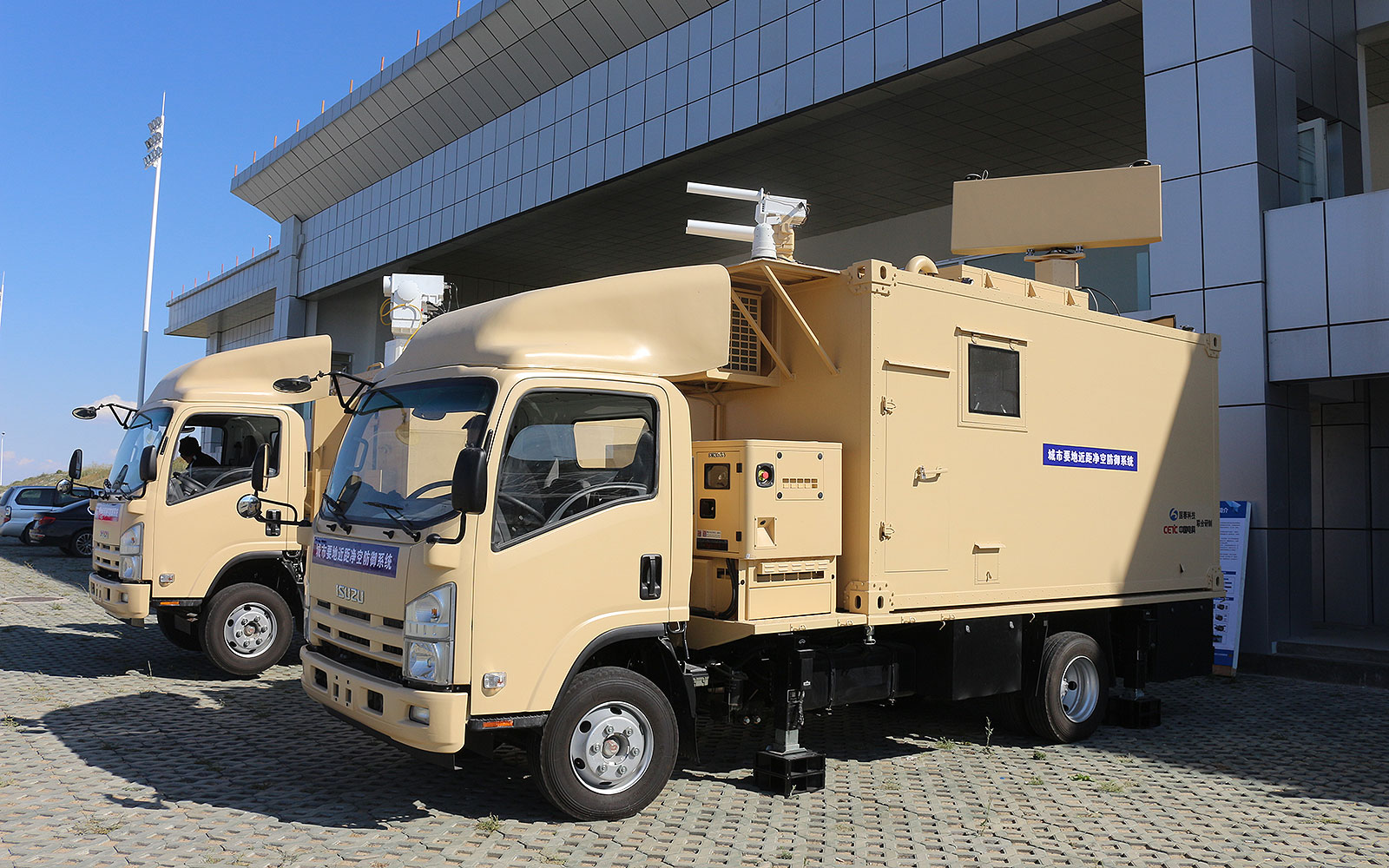
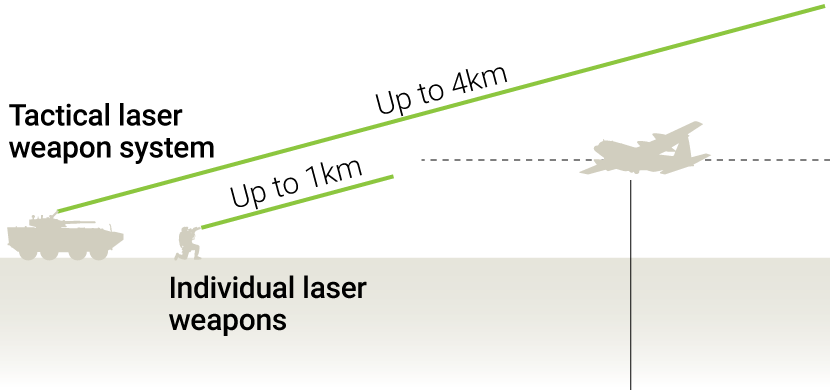 Individual laser weapons
Individual laser weaponsChina has also developed several types of low-power hand-held laser guns. These are used to dazzle or blind the enemy from short-range, or to damage the enemy’s night-vision devices.
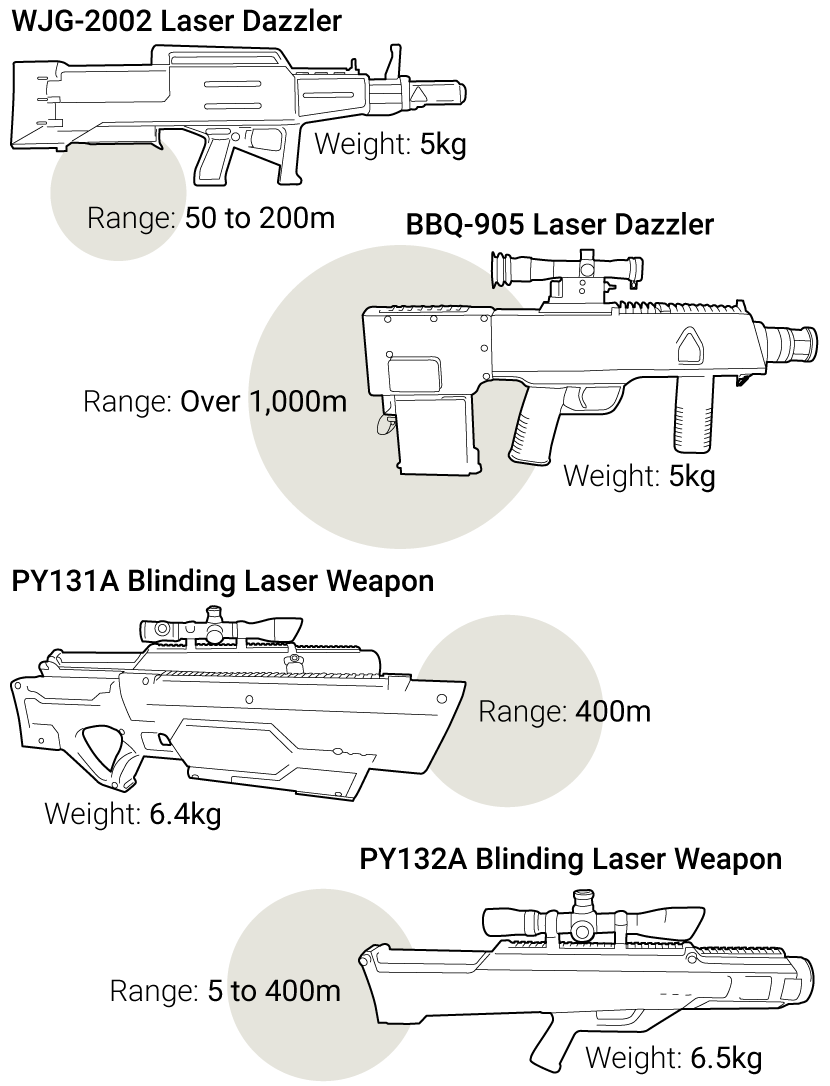 While it is unclear what lasers were used, this incident raises a worrying question. Can the armed forces of so many countries with competing agendas continue to cooperate in a small space without frictions boiling over?
While it is unclear what lasers were used, this incident raises a worrying question. Can the armed forces of so many countries with competing agendas continue to cooperate in a small space without frictions boiling over?
Historical parallels with the first overseas US military base
When the US economy began to pull away from its European rivals at the turn of the 20th century, the nascent powerhouse needed a foreign base to protect its overseas interests
Signs of a rising power
The US established Guantanamo Bay, Cuba, as its first overseas military base in 1903, at a time when its economic and military might was beginning to surpass that of its competitors. China’s recent economic rise mirrors that of the US at the turn of the 20th century and Beijing appears to be making similar moves in international diplomacy. Djibouti might have more in common with Guantanamo Bay than first meets the eye.
It is interesting to note that the US and China established their first overseas military bases at similar stages of their economic and political development.
In 1903 the US had a roughly 20 per cent share of major powers’ GDP — similar to what China has now, and began to tentatively assert itself on the world stage. Both considered themselves influential enough to justify establishing overseas bases to provide military support for their growing trade interests.
They also have in common a shared language describing themselves as anti-colonial peace brokers using trade to promote stability. As well as military facilities, the bases served as refuelling stations for their international fleets. Coal, in the case of Guantanamo, and oil in that of Djibouti.
Economic history
Share of GDP by major powers (%)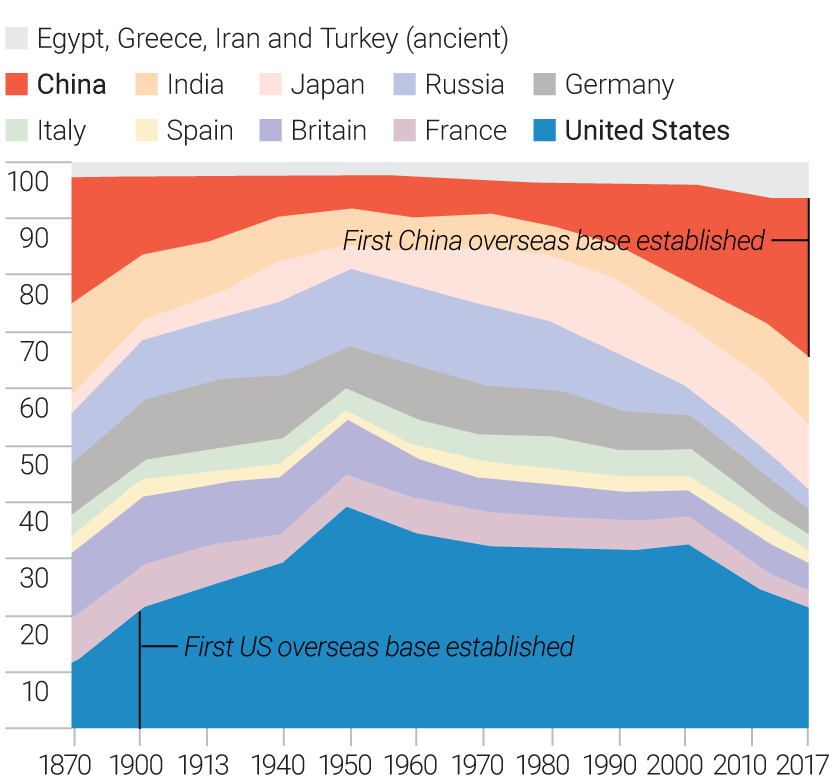 Sources: Angus Maddison, IMF
Sources: Angus Maddison, IMF
History repeats itself
China’s current economic clout, and that of the US 100 years ago, is also mirrored by the similarity of the two nation’s growing self-confidence at the same point in their development. The two fledgling powers acquired their bases by convincing their partners that it would be in the mutual interests of all concerned – albeit through somewhat different means.
Guantanamo was seized by the US when it ‘liberated’ Cuba from Spain, a European colonial power in decline. Doraleh Container Terminal was secured from Djibouti, a former French colony, through active diplomacy that challenges a US-centric world order.
Guardians of trade
On June 9, 1898, in the early days of the Spanish-American War, American forces landed in Guantanamo Bay and quickly realised the need for a safe harbour to reinforce their Cuban allies. With the hurricane season that year unleashing 11 storms, Guantanamo Bay provided the perfect natural storm shelter.
Overseas US military bases 2017
Global shipping routes in 1904
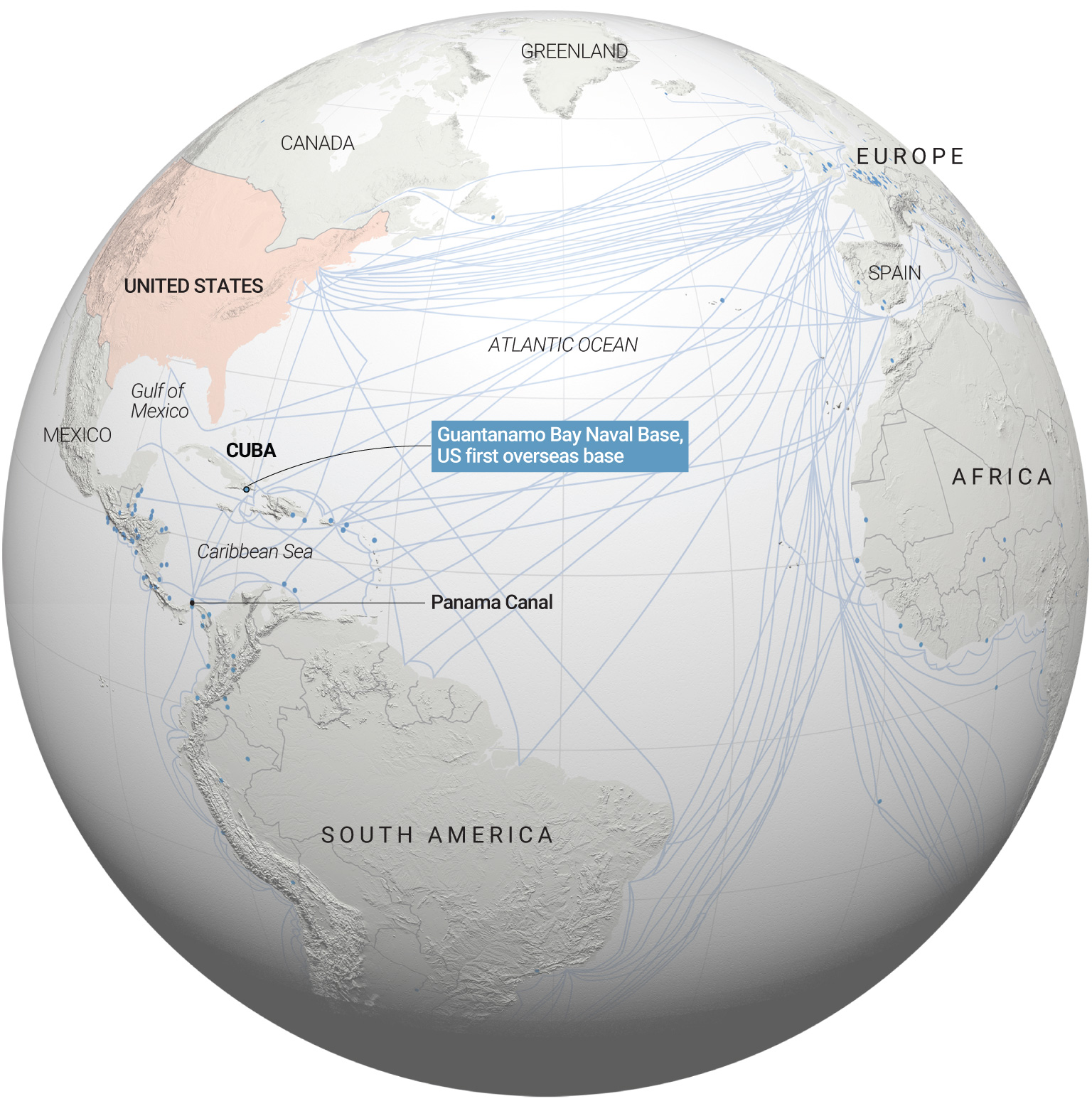
The victorious American forces signed the Treaty of Paris with Spain in December of that same year. The treaty granted Puerto Rico, Guam, and the Philippines US territory status, while Cuba remained nominally independent. The new Cuban government signed a lease granting the US permission to use Guantanamo Bay as a coaling and naval station, which the US has held ever since.
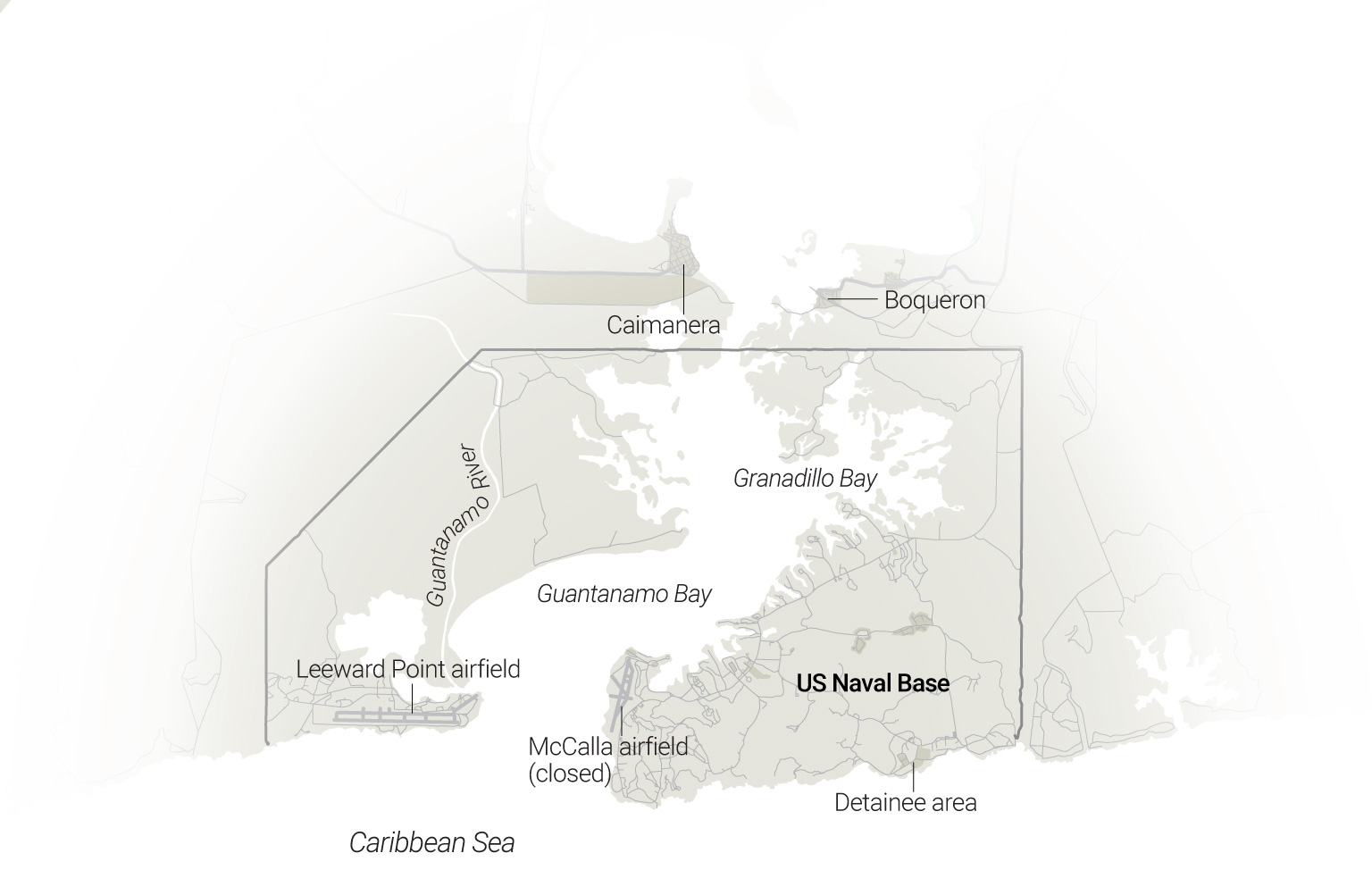
The bay was taken by US and Cuban forces during the Spanish-American War
The US took over construction of the Panama Canal in 1904. This key piece of regional infrastructure slashed travel times between the Atlantic and Pacific oceans greatly enhancing international trade. Over the next few decades the US embarked on numerous overseas infrastructure projects and continued an extended period of domestic infrastructure engineering projects, not ulike China’s current “Belt and Road” ambitions. The similarities between the two bases tends to end here for the time being.
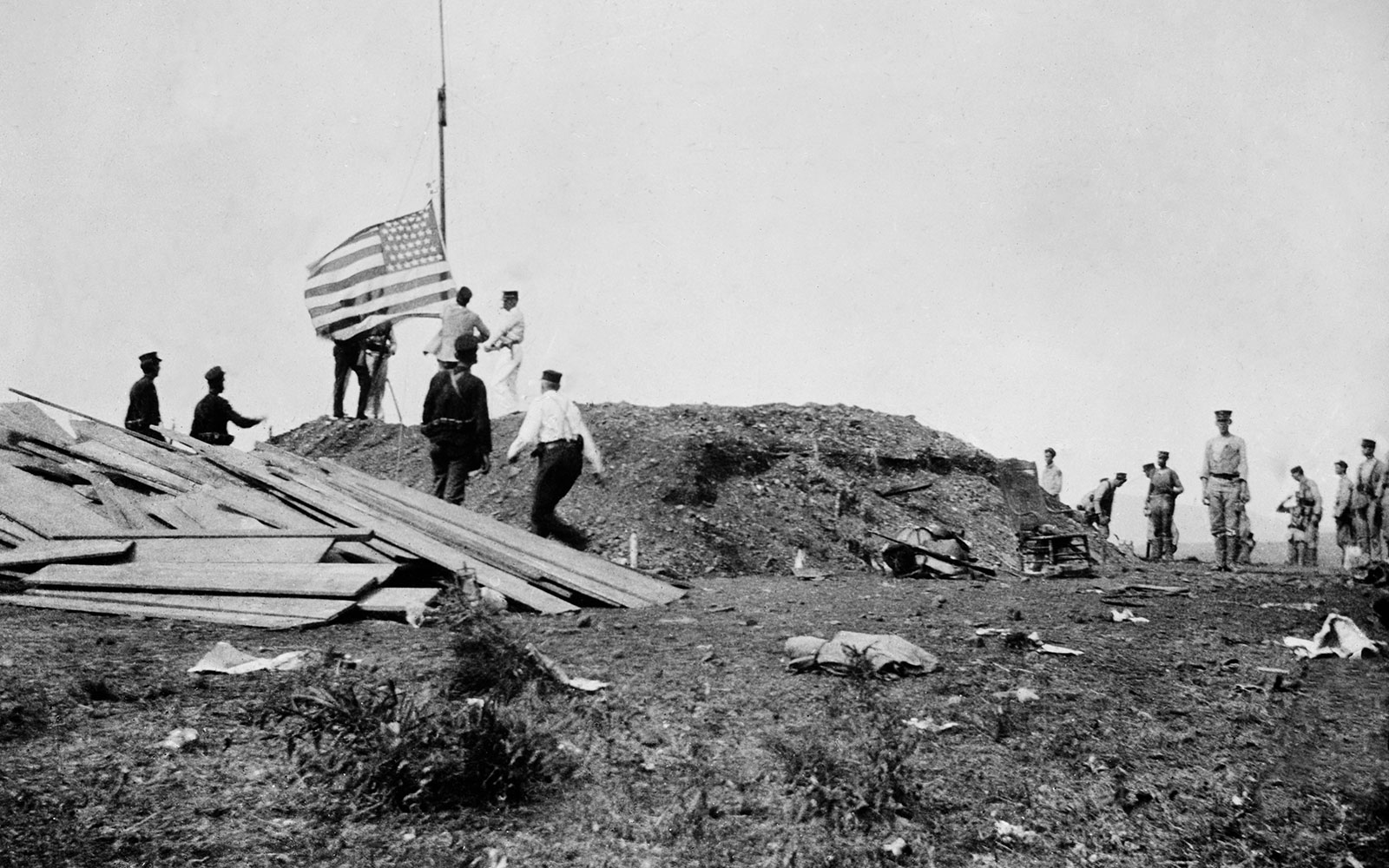

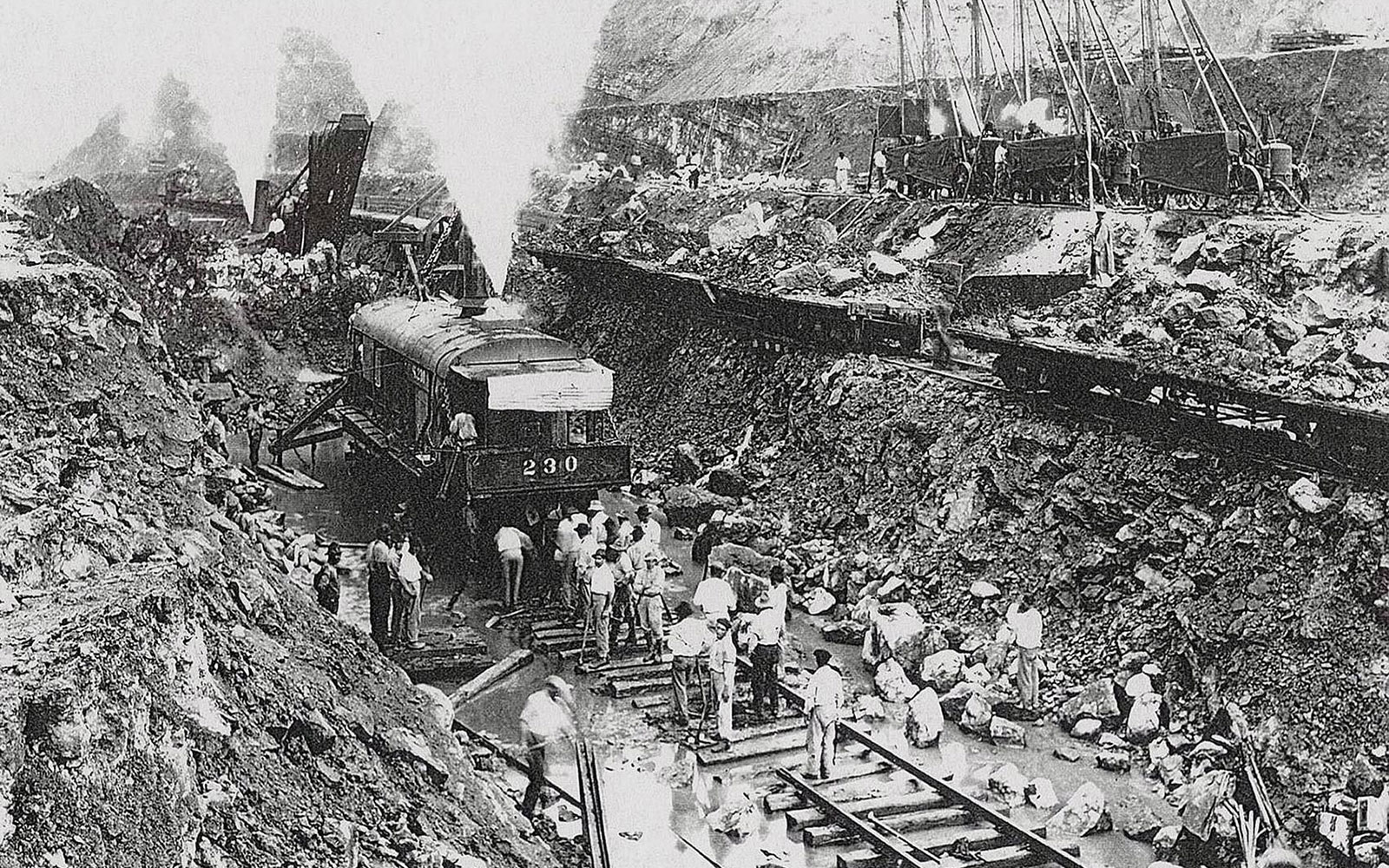

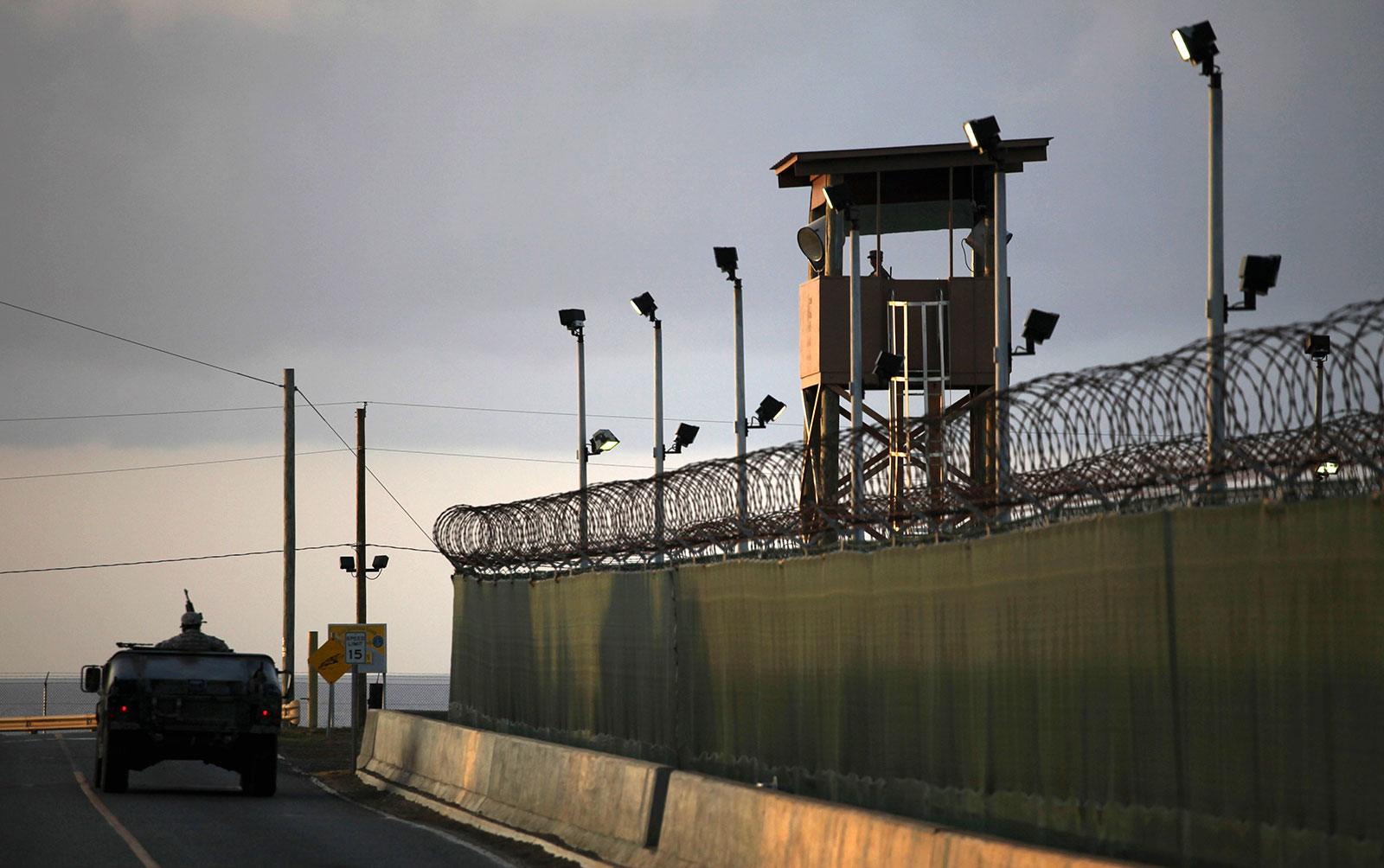
The Cuban-American Treaty of Relations was signed in 1934 reaffirming the lease in perpetuity unless both governments agree to break the lease. The base proved crucial for the US during the second world war as a strategic refuelling and distribution depot for military and merchant shipping, as well as an anti-submarine training site.
The agreement became a bone of contention after the Cuban Revolution and remained a source of cold war tension until the collapse of the Soviet Union in 1991. That same year droves of Haitians fled their country following a coup d’état. Those picked up in international waters were brought to Guantanamo where many were declared economic, not political, migrants, and returned to Haiti. Others were screened for HIV, and denied entry into the US if tested positive.
This episode became something of a blueprint for events post-2001. Following the terrorist attacks of September 11, the US established an offshore prison site to incarcerate people deemed enemy combatants in the US-led “war on terror.”




